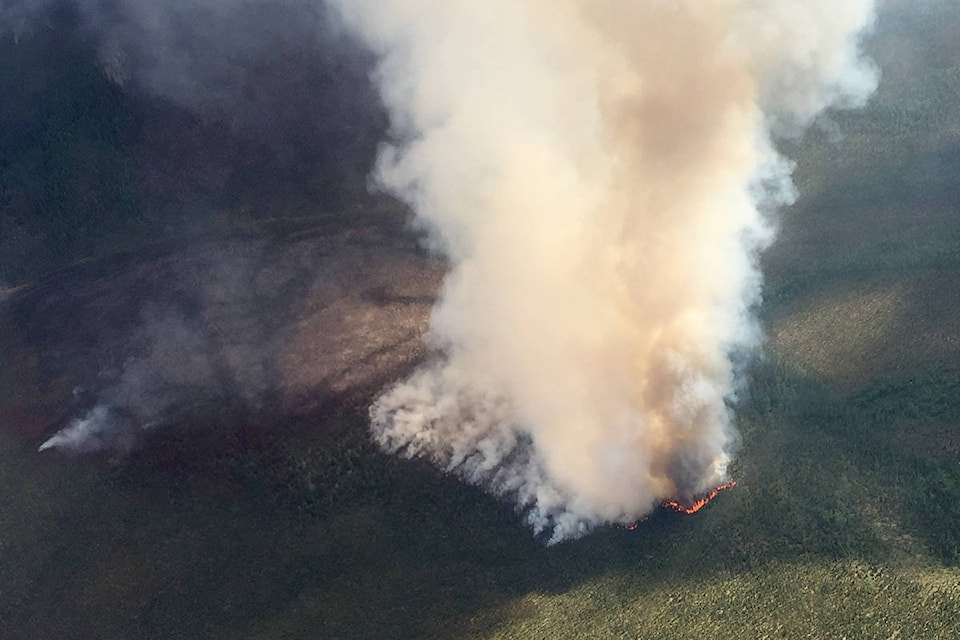In August 2014 my wife and I packed up our belongings in a U-haul trailer and left Yellowknife for Dawson City.
We barely made it out. The year was one of the worst summers for forest fires in the Northwest Territories in recent memory. Highway closures were so frequent that grocery stores started to run low on fresh produce. The day we hit the road, the Yellowknife Highway closed — again — to traffic about an hour after we made it through.
With good reason. The landscape around Tu Nedhe (Great Slave Lake), mostly flat Canadian Shield covered in scrubby little jack pines, looked like it had been nuked. Trees were scorched to almost nothing. The dirt was on fire. Thick, acrid smoke burned the eyes. We drove the three hours to Fort Providence with the windows up, even though the weather was hot and sunny.
That summer, more than 2.8 million acres — an area equivalent to half of Nova Scotia — went up in smoke. Things grew so dire that for a while, rumours circulated that the city was planning for the worst case scenario: a desperate last stand with the residents huddled inside two large recreation buildings buttressed with dirt ramparts and firehoses. This was quickly shot down by civic officials. Still, people were rattled.
These worries were only partly the figment of a runaway public imagination. It has become an annual summer ritual in much of the Canadian West and North: Whose turn is it to face an existential threat from forest fires?
In 2011 a third of Slave Lake, Alta., burned down, leaving more than 700 people homeless and causing $700 million in damage.
Much the same thing, of course, happened to Fort McMurray last summer, and for a couple of days it looked like a distinct possibility that a city of 100,000 might burn to the ground completely. In the end “The Beast” torched 2,400 buildings and caused $3.6 billion worth of damage.
This summer’s fires in British Columbia are the latest chapter in this story. This year’s blazes have displaced 45,000 people in B.C.’s interior, and burned more than 3,200 hectares.
The financial cost will not be known for a while, but the psychological strain is already apparent. Recently, in Williams Lake, a 44-year man threatened firefighters conducting a back burn with a handgun. Last week a tense standoff took place after RCMP officers (foolishly) threatened to take away children from the Tl’etinqox First Nation, which had trained firefighters ready to battle the flames.
The threat is not new to Canada’s so-called hinterland, of course. The Yukon has had plenty of major fires of its own, like Fox Lake in 1998, which torched 45,000 hectares. The Great Fire of 1922 in the Timiskaming region of Ontario totally destroyed four whole towns and killed 43 people. Indigenous people in North America have long known how to manage the risk of out-of-control forest fires by burning underbrush, a practice that’s been adopted by contemporary forestry officials everywhere.
But climate change is making the frequency and intensity of forest fires ever more serious as temperatures rise and the woods become more dry. Writing for The Conversation, Merritt Turetsky, a biologist with the University of Guelph, warns that the changing forest fire regime could alter the very makeup of the boreal forest itself.
We know fire in moderation is good for forests. It’s part of the cycle of decay and regrowth. But in areas where coniferous trees (the ones with needles) dominate, Turetsky writes, intense fires encourage deciduous trees (the ones with leaves) to encroach.
“There is no doubt that such an important shift in the makeup of Canadian forests will have winners and losers. Some animals may thrive with the better forage quality produced by deciduous species, while others will lose important habitat,” she writes.
“A loss of conifer forest area would mean big changes for how the boreal biome interacts with the Earth’s climate system. The consequences of fire-induced shifts in the structure of boreal forests would be far ranging from small-scale changes in biodiversity to global-scale changes in albedo (the amount of the sun’s energy reflected back into space) and greenhouse gas emissions.”
In other words, wildfires would become part of the dreaded climate change feedback loop, where the symptoms of climate change in turn cause even more climate change.
Perhaps you don’t believe in all that hippie climate change crap. Al Gore made it up to take more of your hard-earned money or whatever. Roll that coal. Drill baby drill. Nothing I’ve written here will change your mind.
Even so, you might want to make sure you have a good quality hose nearby. One of these days, you’re going to need it.
Contact Chris Windeyer at editor@yukon-news.com
